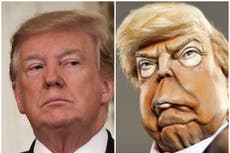Who could possibly be offended by this toothless series of Spitting Image?
Spitting Image used to have some bite but it is now little more than a bizarre celebration of its targets


We have all been waiting eagerly for the return of Spitting Image, keen to see how a new generation of politicians and celebrities will be mercilessly satirised. So far, however, the series has spectacularly missed the mark.
One reviewer wrote that Spitting Image is a “welcome return for comedy that revels in giving offence”. But who, really, could be offended by this latest offering? Members of this government? Hardly – I suspect they are only too pleased to be seen as cartoonish villains, rather than have audiences interrogate their politics.
It might be useful at this point to return to the definition of satire: criticising people or ideas in a humorous way, especially in order to make a political point. Spitting Image fails to deliver any real “political point” or message. Making government ministers look grotesque is not the radical satire the creators seem to think it is. There was a certain novelty appeal when the original series aired in the 1980s but, second time around, it all feels far less interesting.
In an interview with Radio Times, the show’s creator Roger Law stated that “[personal parody] has more effect on individuals than waxing lyrical about their policies”. Does it? The physical appearance of government ministers is not the problem, nor does it have any bearing on their role in government. By focusing on appearances, the makers of Spitting Image have conjured a veil to hide behind, allowing them to avoid engaging in substantial criticism. Put it this way: Boris Johnson and Michael Gove will have no problems brushing off jibes about fluffy hair and rosy cheeks.
The words of British writer and director Chris Morris, famous for satirical works including Brass Eye and Four Lions, spring to mind. “I don’t really see the point of comedy unless there is something underpinning it. I mean, what are you doing,” he asked in a 2019 interview. “Are you doing some sort of exotic display for the court, to be patted on the head by the court, or are you trying to change something?”
The implications of this – that satire without a strong urge to change or upset the status quo is merely pandering to those it claims to criticise – is true of this latest series of Spitting Image. Much of the content thus far barely registers as satire; it just retells the story of current events with puppets and awkward pauses – where the laughter ought to be.
One example is the scene in which Priti Patel, as a vampiric dominatrix, treats a submissive Michael Gove to her “unpopular conservative opinions”, meant to highlight Patel’s ability to continually escape significant criticism due to her position as an Asian woman. “If single mothers can’t afford babies, they should have abortions,” says puppet-Patel. “If they want abortions, they shouldn’t have had sex.” Puppet-Gove replies: “Yes, you can say it because you’re a woman.”
This scene could have provided insight into how Conservative women often escape criticism due to the stereotype of women as more caring and likely to have the interests of the needy in mind. However, it barely acknowledges this. Instead, the audience is placed in puppet-Gove's position, powerless to escape having these Tory tactics rubbed in our faces.
Beyond showing Patel as a more acceptable mouthpiece for these extreme views, oversexualising her character (a cheap and lazy depiction of women of colour, which we really should have moved on from) and the light name-calling of Gove as “dull”, the scene fails to land a blow on either figure, their policies or ideals.
Spitting Image has a legacy of helping rather than hindering the politicians it depicts. While the original 1980s series was airing, its central figures enjoyed their treatment on the show. Edwina Currie claimed that “to get noticed was great – it suggested I was getting my message across”, adding that “those [members of the cabinet] who weren’t in it, really wanted to be in it”, and that “Margaret Thatcher loved Spitting Image”. Ahead of this current series, Piers Morgan joked that he had “waited all [his] adult life to have Spitting Image do a puppet of [him]”.
All this illustrates that the show’s supposedly brutal satire holds no real fear for those it depicts. It is, conversely, seen as a mark of prestige to be included. How can Spitting Image achieve any meaningful satire or criticism of those in power if it doesn’t even bother them?
Join our commenting forum
Join thought-provoking conversations, follow other Independent readers and see their replies
Comments


Bookmark popover
Removed from bookmarks